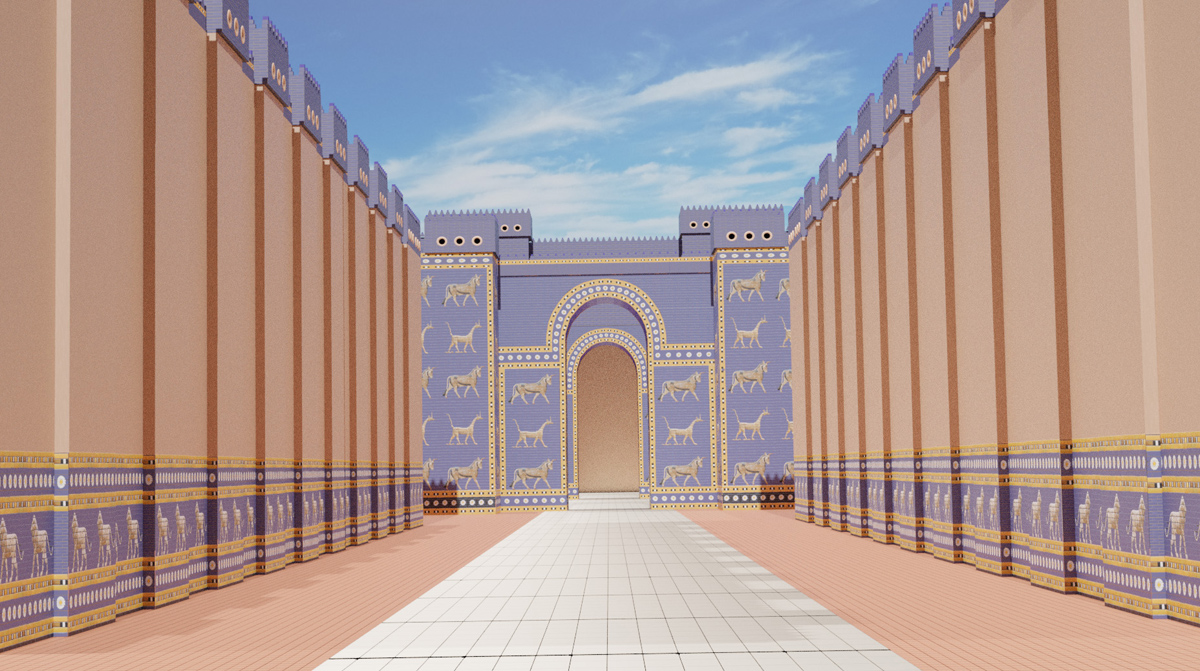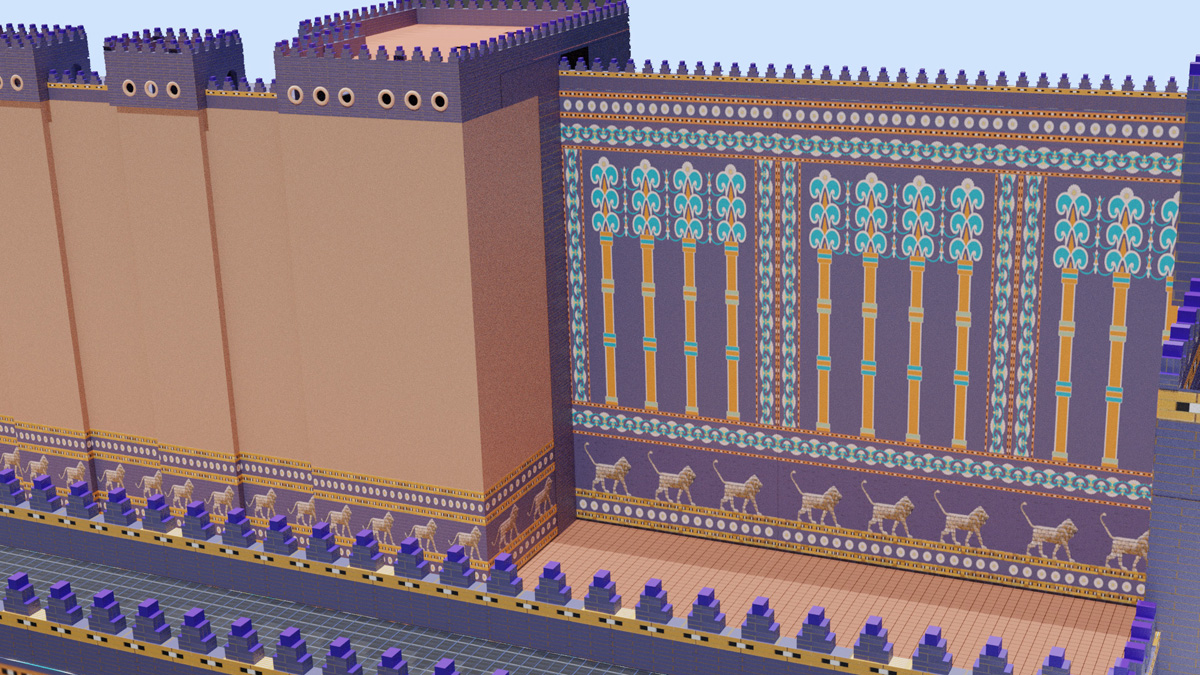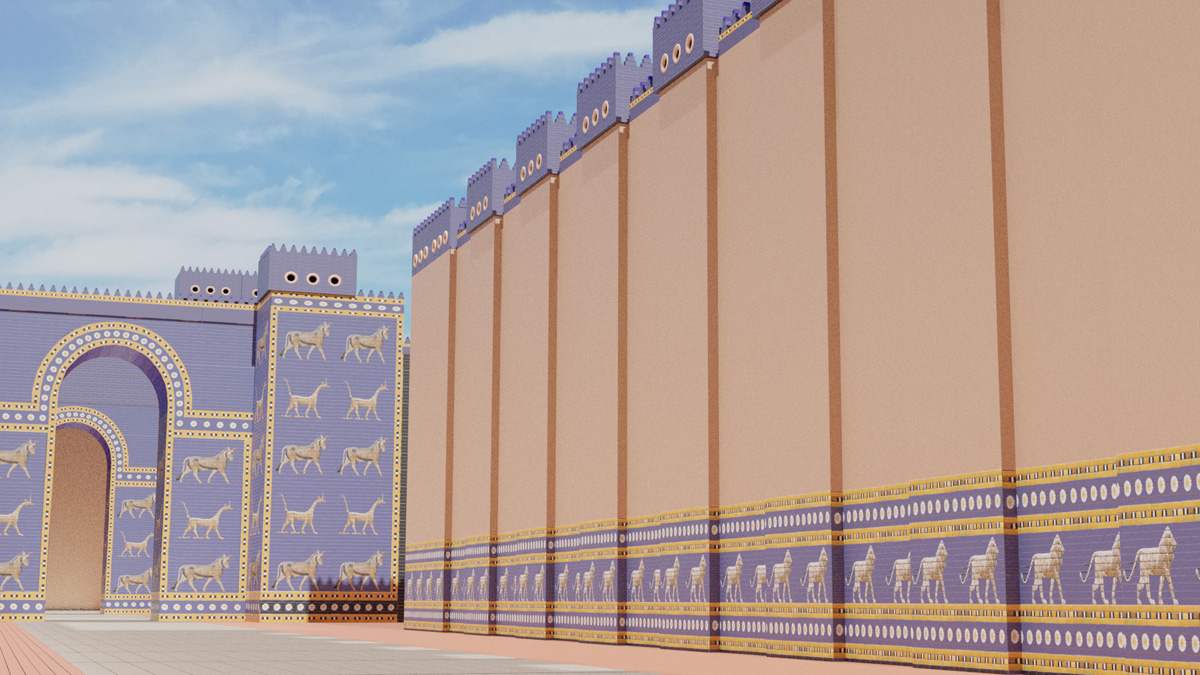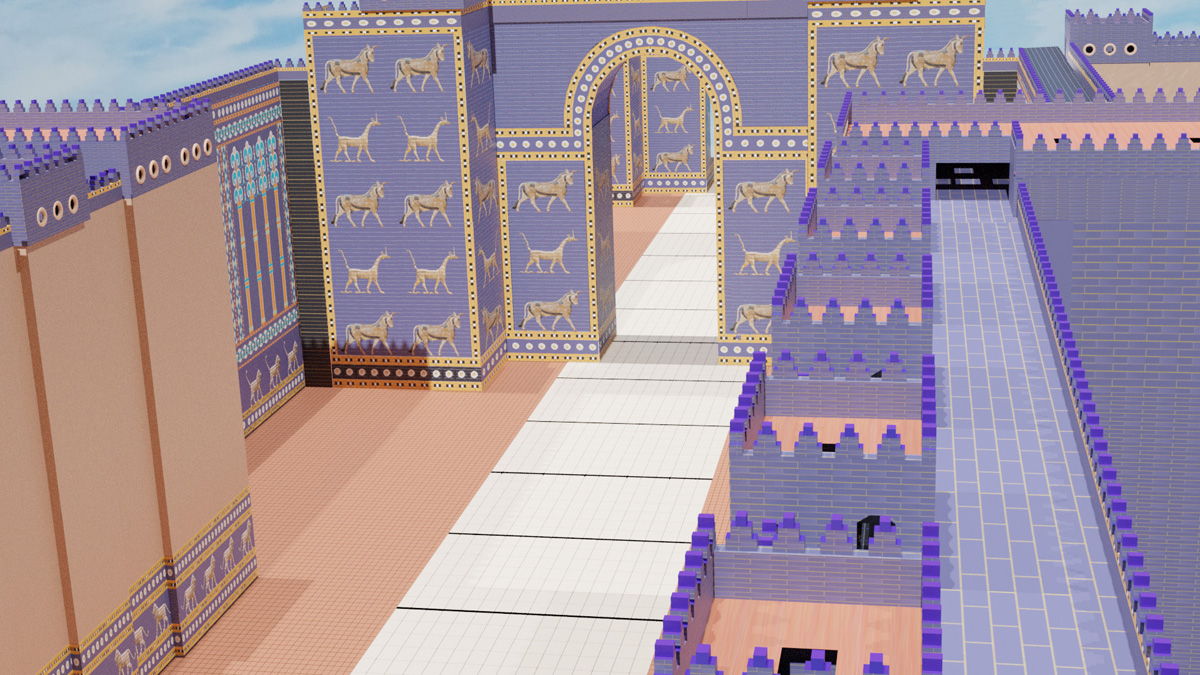Babylon, and the Babylonian Language
Babylon was founded sometime before 2300 BC, it is located roughly 60 miles south-west of the present-day city of Baghdad. It is believed that the name Babylon came from the Babylonian
language, bav-ilim, which means Gate of the God(s). Indeed, at least in later times, there were
gates build in honor of the gods, as was Ishtar Gate, built by Nabuchadnezzar II circa 620BC.
The city of Babylon at that time occupied about 2,200 acres of land!
 Ishtar Gate, as depicted above, was created by Nebuchadnezzar's craftsmen circa 575 BC, it was one of a total of eight
gates in Babylon, it is said also that the Hanging Gardens were built in Babylon also, Herodotus mentions that they
used lead as a sealant to prevent water from the upper stages from trickling through from the top floors of it to the
bottom, and I am wondering, hey, archeologists . . . . if one of you happens to be reading this, the lead thing is a
dead giveaway ... if you want to find these hanging gardens, have a chemist test the soil for lead!
Ishtar Gate, as depicted above, was created by Nebuchadnezzar's craftsmen circa 575 BC, it was one of a total of eight
gates in Babylon, it is said also that the Hanging Gardens were built in Babylon also, Herodotus mentions that they
used lead as a sealant to prevent water from the upper stages from trickling through from the top floors of it to the
bottom, and I am wondering, hey, archeologists . . . . if one of you happens to be reading this, the lead thing is a
dead giveaway ... if you want to find these hanging gardens, have a chemist test the soil for lead!
 The Ishtar Gate of course, was named after the Goddess Ishtar, who seems to have been initially refered to by the
Summerians as Inanna, Inanna was the goddess of love, sensuality, fertility, and war. Ishtar, is seems, is the
first known deity for which we have any written records, and was worshiped for thousands of years! Ishtar was
associated with the planet Venus, so she must have been really hot! If you read through Ishtar's Descent to
the Netherworld, you will find what appears to have been her descent into what the Ancient Greeks referred to as
Hades, the place where the dead go when they die.
Interesting it is, that in this Hymn to Ishtar . . . the earth is referred to as an "orb"!
Ammi-ditāna's hymn to Ištar read by K. Hecker:
Ammi-ditāna's hymn to Ishtar
The purpose of Ishtar's descent was to obtain the waters of life and revive her bridegroom Tammuz. You can find a more
in depth description of this event in
The Descent of Ishtar.
The Epic of Gilgamesh: Discover the ancient Mesopotamian epic that chronicles the legendary adventures
of Gilgamesh, a heroic king on a quest for immortality. Explore themes of friendship, mortality, and the search for meaning
in this foundational piece of world literature. Approximate date of the writing of the Epic of Gilgamesh is around 2100 BCE
to 2000 BCE, during the ancient Mesopotamian civilization in what is present-day Iraq. This makes it one of the earliest known
works of literature in human history!
The Epic of Gilgamesh.
In my wanderings through various sources, I was initially led to believe that the language of Babylon was Akkadian, now a dead language, although a well deciphered and understood language . . . . but eventually I stumbled across something a bit deeper than just that and lo . . . . It was not Akkadian . . . . it was Babylonian! Akkadian is a generalization, but I am getting ahead of myself here. Babylonian is the genuine language spoken by those who lived in Babylon, and Assyrian was spoken by those to the north of Babylon . . . . the two languages, Babylonian and Assyrian are very similar, and are often referred to as Akkadian in that respect! As a book by Martin Worthington Complete Babylonian, states, understanding Babylonian is about 90% of the way toward understanding Assyrian. Babylon was no small city, circa 600 BC is consisted of 2,200 acres of land.
Speaking of Martin Worthington and his book Complete Babylonian, you can find the first edition online at
Martin Worthington Teach Yourself Babylonian
The Ishtar Gate of course, was named after the Goddess Ishtar, who seems to have been initially refered to by the
Summerians as Inanna, Inanna was the goddess of love, sensuality, fertility, and war. Ishtar, is seems, is the
first known deity for which we have any written records, and was worshiped for thousands of years! Ishtar was
associated with the planet Venus, so she must have been really hot! If you read through Ishtar's Descent to
the Netherworld, you will find what appears to have been her descent into what the Ancient Greeks referred to as
Hades, the place where the dead go when they die.
Interesting it is, that in this Hymn to Ishtar . . . the earth is referred to as an "orb"!
Ammi-ditāna's hymn to Ištar read by K. Hecker:
Ammi-ditāna's hymn to Ishtar
The purpose of Ishtar's descent was to obtain the waters of life and revive her bridegroom Tammuz. You can find a more
in depth description of this event in
The Descent of Ishtar.
The Epic of Gilgamesh: Discover the ancient Mesopotamian epic that chronicles the legendary adventures
of Gilgamesh, a heroic king on a quest for immortality. Explore themes of friendship, mortality, and the search for meaning
in this foundational piece of world literature. Approximate date of the writing of the Epic of Gilgamesh is around 2100 BCE
to 2000 BCE, during the ancient Mesopotamian civilization in what is present-day Iraq. This makes it one of the earliest known
works of literature in human history!
The Epic of Gilgamesh.
In my wanderings through various sources, I was initially led to believe that the language of Babylon was Akkadian, now a dead language, although a well deciphered and understood language . . . . but eventually I stumbled across something a bit deeper than just that and lo . . . . It was not Akkadian . . . . it was Babylonian! Akkadian is a generalization, but I am getting ahead of myself here. Babylonian is the genuine language spoken by those who lived in Babylon, and Assyrian was spoken by those to the north of Babylon . . . . the two languages, Babylonian and Assyrian are very similar, and are often referred to as Akkadian in that respect! As a book by Martin Worthington Complete Babylonian, states, understanding Babylonian is about 90% of the way toward understanding Assyrian. Babylon was no small city, circa 600 BC is consisted of 2,200 acres of land.
Speaking of Martin Worthington and his book Complete Babylonian, you can find the first edition online at
Martin Worthington Teach Yourself Babylonian
 So let's wander some more from our daily musings and consider another interesting tidbit.
Atrahasis . . . . Atra-Hasis is a Babylonian myth, (or you could say Akkadian myth, whichever you prefer) with Atrahasis as the main character . . . from the 18th century BC . . . . so that puts it at roughly 3,800 years ago. This story came down to us from writing on clay tablets. Atrahasis also meaning - exceedingly wise, and was said to have been one of the rulers of the city of Shuruppak. (Shuruppak in itself is a very ancient and interesting subject, but I will not diverge here.) So Atra-Hasis starts with a myth of the creation of man, pre-dated by three Sumerian gods:
Anu - God of the sky - ruler of the sky.
Enlil - God of the wind - ruler of the earth.
Enki - God of water - ruler of the freshwater sea.
Initially, there were dingirs (minor divine beings) to do farm labor, maintain the rivers and canals. But these being some form of divine, rebelled against such labor, and as a result, humans were created to do this work. As population increases, Enlil, the god of earth sends famine and drought in intervals of 1200 years. Eventually, Enlil secretly decides to destroy humans by flooding them out, and tells Enki of his plan making sure he was sworn to secrecy first. Enki however, being the good and decent god he was, breaks with the oath, and tells Atrahasis of this plan by speaking through a reed wall to him. He advises Atrahasis to build a boat with upper and lower decks, sealed with bitumen. With his family and animals aboard, he seals the door, and the storm and flood does as Enlil bidded it, destroying humans, all save Atrahasis and his family. After seven days, the flooding has ended. When Enlil discovers the deception, he is angry with Enlil, but eventually they agree to use other means for controlling human population. The Epic of Gilgamesh was written after this account, and used the name Utnapishtim rather than Atrahasis.
The Assyrian Dictionary of the Oriental Institute of the University of Chicago (CAD)
Assyrian Dictionary
So let's wander some more from our daily musings and consider another interesting tidbit.
Atrahasis . . . . Atra-Hasis is a Babylonian myth, (or you could say Akkadian myth, whichever you prefer) with Atrahasis as the main character . . . from the 18th century BC . . . . so that puts it at roughly 3,800 years ago. This story came down to us from writing on clay tablets. Atrahasis also meaning - exceedingly wise, and was said to have been one of the rulers of the city of Shuruppak. (Shuruppak in itself is a very ancient and interesting subject, but I will not diverge here.) So Atra-Hasis starts with a myth of the creation of man, pre-dated by three Sumerian gods:
Anu - God of the sky - ruler of the sky.
Enlil - God of the wind - ruler of the earth.
Enki - God of water - ruler of the freshwater sea.
Initially, there were dingirs (minor divine beings) to do farm labor, maintain the rivers and canals. But these being some form of divine, rebelled against such labor, and as a result, humans were created to do this work. As population increases, Enlil, the god of earth sends famine and drought in intervals of 1200 years. Eventually, Enlil secretly decides to destroy humans by flooding them out, and tells Enki of his plan making sure he was sworn to secrecy first. Enki however, being the good and decent god he was, breaks with the oath, and tells Atrahasis of this plan by speaking through a reed wall to him. He advises Atrahasis to build a boat with upper and lower decks, sealed with bitumen. With his family and animals aboard, he seals the door, and the storm and flood does as Enlil bidded it, destroying humans, all save Atrahasis and his family. After seven days, the flooding has ended. When Enlil discovers the deception, he is angry with Enlil, but eventually they agree to use other means for controlling human population. The Epic of Gilgamesh was written after this account, and used the name Utnapishtim rather than Atrahasis.
The Assyrian Dictionary of the Oriental Institute of the University of Chicago (CAD)
Assyrian Dictionary
 © All Ishtar Gate images created using Blender and Photoshop, by Archeus Lore, 2020
© All Ishtar Gate images created using Blender and Photoshop, by Archeus Lore, 2020
 Ishtar Gate, as depicted above, was created by Nebuchadnezzar's craftsmen circa 575 BC, it was one of a total of eight
gates in Babylon, it is said also that the Hanging Gardens were built in Babylon also, Herodotus mentions that they
used lead as a sealant to prevent water from the upper stages from trickling through from the top floors of it to the
bottom, and I am wondering, hey, archeologists . . . . if one of you happens to be reading this, the lead thing is a
dead giveaway ... if you want to find these hanging gardens, have a chemist test the soil for lead!
Ishtar Gate, as depicted above, was created by Nebuchadnezzar's craftsmen circa 575 BC, it was one of a total of eight
gates in Babylon, it is said also that the Hanging Gardens were built in Babylon also, Herodotus mentions that they
used lead as a sealant to prevent water from the upper stages from trickling through from the top floors of it to the
bottom, and I am wondering, hey, archeologists . . . . if one of you happens to be reading this, the lead thing is a
dead giveaway ... if you want to find these hanging gardens, have a chemist test the soil for lead!
 The Ishtar Gate of course, was named after the Goddess Ishtar, who seems to have been initially refered to by the
Summerians as Inanna, Inanna was the goddess of love, sensuality, fertility, and war. Ishtar, is seems, is the
first known deity for which we have any written records, and was worshiped for thousands of years! Ishtar was
associated with the planet Venus, so she must have been really hot! If you read through Ishtar's Descent to
the Netherworld, you will find what appears to have been her descent into what the Ancient Greeks referred to as
Hades, the place where the dead go when they die.
Interesting it is, that in this Hymn to Ishtar . . . the earth is referred to as an "orb"!
Ammi-ditāna's hymn to Ištar read by K. Hecker:
Ammi-ditāna's hymn to Ishtar
The purpose of Ishtar's descent was to obtain the waters of life and revive her bridegroom Tammuz. You can find a more
in depth description of this event in
The Descent of Ishtar.
The Epic of Gilgamesh: Discover the ancient Mesopotamian epic that chronicles the legendary adventures
of Gilgamesh, a heroic king on a quest for immortality. Explore themes of friendship, mortality, and the search for meaning
in this foundational piece of world literature. Approximate date of the writing of the Epic of Gilgamesh is around 2100 BCE
to 2000 BCE, during the ancient Mesopotamian civilization in what is present-day Iraq. This makes it one of the earliest known
works of literature in human history!
The Epic of Gilgamesh.
In my wanderings through various sources, I was initially led to believe that the language of Babylon was Akkadian, now a dead language, although a well deciphered and understood language . . . . but eventually I stumbled across something a bit deeper than just that and lo . . . . It was not Akkadian . . . . it was Babylonian! Akkadian is a generalization, but I am getting ahead of myself here. Babylonian is the genuine language spoken by those who lived in Babylon, and Assyrian was spoken by those to the north of Babylon . . . . the two languages, Babylonian and Assyrian are very similar, and are often referred to as Akkadian in that respect! As a book by Martin Worthington Complete Babylonian, states, understanding Babylonian is about 90% of the way toward understanding Assyrian. Babylon was no small city, circa 600 BC is consisted of 2,200 acres of land.
Speaking of Martin Worthington and his book Complete Babylonian, you can find the first edition online at
Martin Worthington Teach Yourself Babylonian
The Ishtar Gate of course, was named after the Goddess Ishtar, who seems to have been initially refered to by the
Summerians as Inanna, Inanna was the goddess of love, sensuality, fertility, and war. Ishtar, is seems, is the
first known deity for which we have any written records, and was worshiped for thousands of years! Ishtar was
associated with the planet Venus, so she must have been really hot! If you read through Ishtar's Descent to
the Netherworld, you will find what appears to have been her descent into what the Ancient Greeks referred to as
Hades, the place where the dead go when they die.
Interesting it is, that in this Hymn to Ishtar . . . the earth is referred to as an "orb"!
Ammi-ditāna's hymn to Ištar read by K. Hecker:
Ammi-ditāna's hymn to Ishtar
The purpose of Ishtar's descent was to obtain the waters of life and revive her bridegroom Tammuz. You can find a more
in depth description of this event in
The Descent of Ishtar.
The Epic of Gilgamesh: Discover the ancient Mesopotamian epic that chronicles the legendary adventures
of Gilgamesh, a heroic king on a quest for immortality. Explore themes of friendship, mortality, and the search for meaning
in this foundational piece of world literature. Approximate date of the writing of the Epic of Gilgamesh is around 2100 BCE
to 2000 BCE, during the ancient Mesopotamian civilization in what is present-day Iraq. This makes it one of the earliest known
works of literature in human history!
The Epic of Gilgamesh.
In my wanderings through various sources, I was initially led to believe that the language of Babylon was Akkadian, now a dead language, although a well deciphered and understood language . . . . but eventually I stumbled across something a bit deeper than just that and lo . . . . It was not Akkadian . . . . it was Babylonian! Akkadian is a generalization, but I am getting ahead of myself here. Babylonian is the genuine language spoken by those who lived in Babylon, and Assyrian was spoken by those to the north of Babylon . . . . the two languages, Babylonian and Assyrian are very similar, and are often referred to as Akkadian in that respect! As a book by Martin Worthington Complete Babylonian, states, understanding Babylonian is about 90% of the way toward understanding Assyrian. Babylon was no small city, circa 600 BC is consisted of 2,200 acres of land.
Speaking of Martin Worthington and his book Complete Babylonian, you can find the first edition online at
Martin Worthington Teach Yourself Babylonian
 So let's wander some more from our daily musings and consider another interesting tidbit.
Atrahasis . . . . Atra-Hasis is a Babylonian myth, (or you could say Akkadian myth, whichever you prefer) with Atrahasis as the main character . . . from the 18th century BC . . . . so that puts it at roughly 3,800 years ago. This story came down to us from writing on clay tablets. Atrahasis also meaning - exceedingly wise, and was said to have been one of the rulers of the city of Shuruppak. (Shuruppak in itself is a very ancient and interesting subject, but I will not diverge here.) So Atra-Hasis starts with a myth of the creation of man, pre-dated by three Sumerian gods:
Anu - God of the sky - ruler of the sky.
Enlil - God of the wind - ruler of the earth.
Enki - God of water - ruler of the freshwater sea.
Initially, there were dingirs (minor divine beings) to do farm labor, maintain the rivers and canals. But these being some form of divine, rebelled against such labor, and as a result, humans were created to do this work. As population increases, Enlil, the god of earth sends famine and drought in intervals of 1200 years. Eventually, Enlil secretly decides to destroy humans by flooding them out, and tells Enki of his plan making sure he was sworn to secrecy first. Enki however, being the good and decent god he was, breaks with the oath, and tells Atrahasis of this plan by speaking through a reed wall to him. He advises Atrahasis to build a boat with upper and lower decks, sealed with bitumen. With his family and animals aboard, he seals the door, and the storm and flood does as Enlil bidded it, destroying humans, all save Atrahasis and his family. After seven days, the flooding has ended. When Enlil discovers the deception, he is angry with Enlil, but eventually they agree to use other means for controlling human population. The Epic of Gilgamesh was written after this account, and used the name Utnapishtim rather than Atrahasis.
The Assyrian Dictionary of the Oriental Institute of the University of Chicago (CAD)
Assyrian Dictionary
So let's wander some more from our daily musings and consider another interesting tidbit.
Atrahasis . . . . Atra-Hasis is a Babylonian myth, (or you could say Akkadian myth, whichever you prefer) with Atrahasis as the main character . . . from the 18th century BC . . . . so that puts it at roughly 3,800 years ago. This story came down to us from writing on clay tablets. Atrahasis also meaning - exceedingly wise, and was said to have been one of the rulers of the city of Shuruppak. (Shuruppak in itself is a very ancient and interesting subject, but I will not diverge here.) So Atra-Hasis starts with a myth of the creation of man, pre-dated by three Sumerian gods:
Anu - God of the sky - ruler of the sky.
Enlil - God of the wind - ruler of the earth.
Enki - God of water - ruler of the freshwater sea.
Initially, there were dingirs (minor divine beings) to do farm labor, maintain the rivers and canals. But these being some form of divine, rebelled against such labor, and as a result, humans were created to do this work. As population increases, Enlil, the god of earth sends famine and drought in intervals of 1200 years. Eventually, Enlil secretly decides to destroy humans by flooding them out, and tells Enki of his plan making sure he was sworn to secrecy first. Enki however, being the good and decent god he was, breaks with the oath, and tells Atrahasis of this plan by speaking through a reed wall to him. He advises Atrahasis to build a boat with upper and lower decks, sealed with bitumen. With his family and animals aboard, he seals the door, and the storm and flood does as Enlil bidded it, destroying humans, all save Atrahasis and his family. After seven days, the flooding has ended. When Enlil discovers the deception, he is angry with Enlil, but eventually they agree to use other means for controlling human population. The Epic of Gilgamesh was written after this account, and used the name Utnapishtim rather than Atrahasis.
The Assyrian Dictionary of the Oriental Institute of the University of Chicago (CAD)
Assyrian Dictionary
